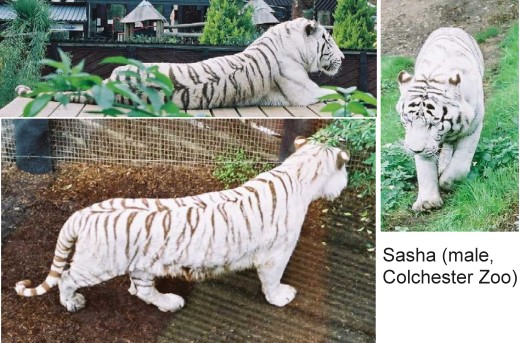
|
WHITE TIGERS IN BRITISH ZOOS (1960s TO RECENT) |
"White gene" vs "Inhibitor gene."
Although these pages refer to "white genes," white tigers have the genes for normal orange colours, but those genes are switched off by a recessive "inhibitor gene." When a tiger inherits 2 copies of the inhibitor gene, the normal orange colour is suppressed. In general parlance, it's simply easier to refer to "white genes."

WHITE TIGERS IN BRITISH ZOOS (1960s TO RECENT)
Several British zoos have held white tigers at one time or another as a way of drawing crowds. Many no longer have white tigers, except as non-breeding rescued animals, as these tigers are mongrelised and have no conservation value. In the 1970s, Longleat Safari Park was home to the Chipperfield Circus animals.
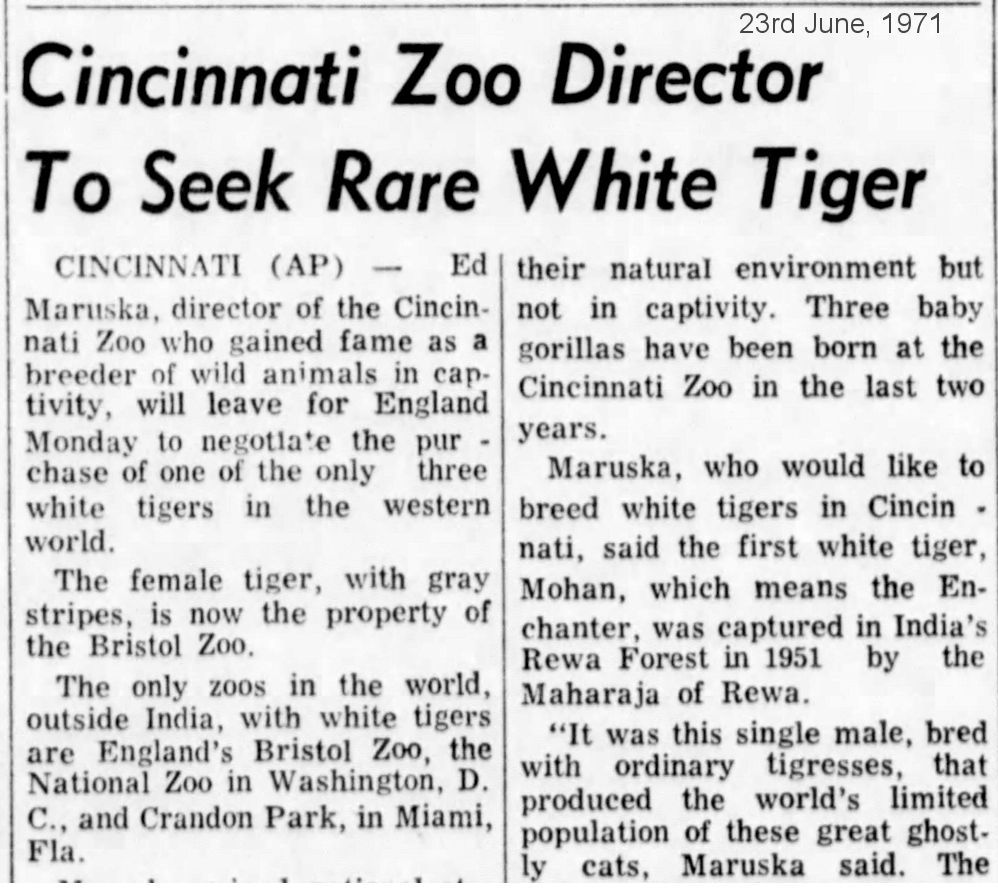
BRISTOL ZOO AND DUDLEY ZOO
In spite of the agreement with New Delhi Zoo, because of the expense of keeping the white tigers the Maharajah threatened to release them all into the forest. As a result he received permission to sell two more pairs to foreign zoos. A brother and sister pair, Champak and Chameli, were sent to Bristol Zoo in 1963 at a cost of $10,000 each (£7,000) where they produced several litters, all white, but only 4 females (Sumuti, Nirmala, Chandra and Shubra) progressed well. According to the Leipzig studbook the pair produced 5 cubs on May 6 1970: 4 females, Nirmala, Seeta, Shubra and Nandini, plus 1 male that died on May 8 1970 at 2 days old. White brother-sister pair Chameli and Champak helped rebuild the fortunes of Bristol Zoo, but by 1973 they still hadn't bred successfully so an orange generic (mixed blood) male from Edinburgh Zoo was tried with a white female, but she failed to rear any cubs. Champak died in 1970. He was replaced in 1975 by Roop (son of Raja and Radha), who had been acquired in 1970. Roop and Sumuti produced white cubs of which Akbar II, Jehand and Chandra survived. Roop and Nirmali produced Shiva.
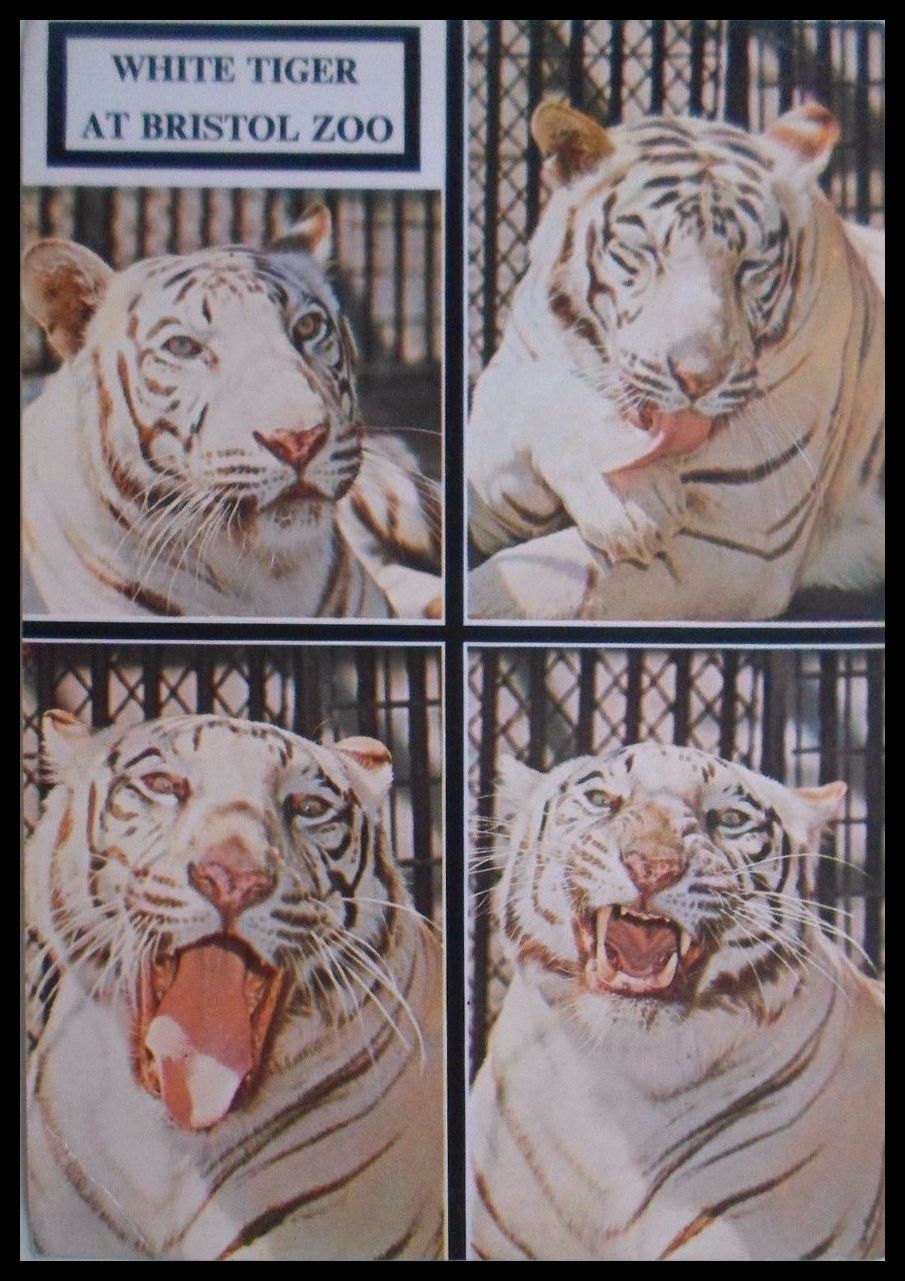
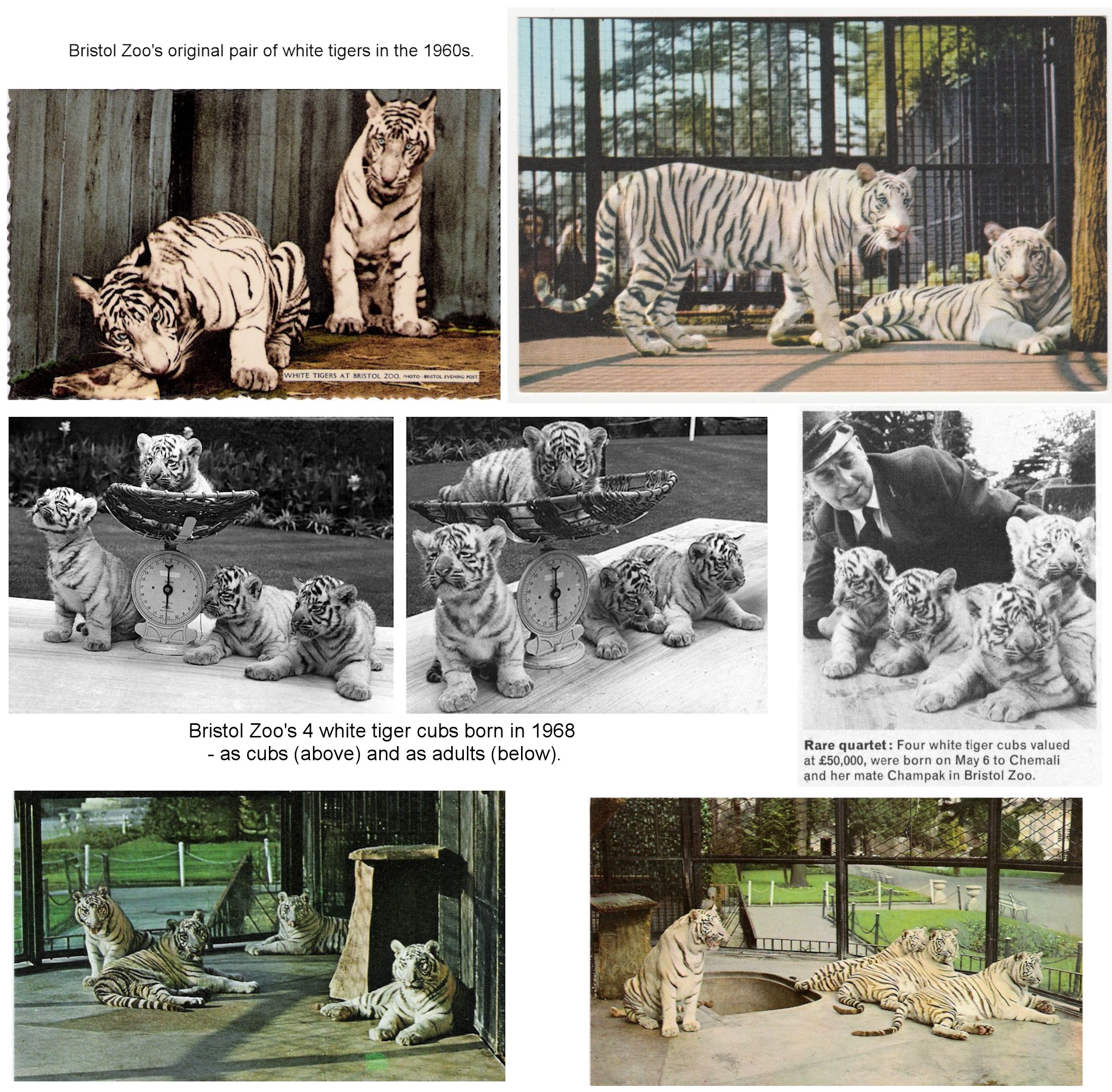
Chart 04: Champak, Chameli and Roop Genealogy (large image, opens in new window)
Around 1963, Bristol Zoo acquired an orange daughter of Mohan and Begum, born April 1955, and this is documented in Geoffrey Schomberg's "The Penguin Guide To British Zoos," (Penguin 1970 ISBN 0-14-146154-X). E.P. Gee said that Bristol Zoo acquired one of Mohan and Begum's female cubs as a mate for Champak "to reduce inbreeding" but if she bred the offspring were unrecorded.
The Cincinnati Zoo tried to buy a white tiger from Bristol Zoo in the early 1970s and got nowhere. Glasgow Zoo also wanted a white tiger from Bristol Zoo, but was also refused and later got a white tigeess on loan from Longleat.
Four white tigers at Bristol Zoo had contracted a spongiform encephalopathy between 1970 and 1977. This was discovered in post mortems and was not linked to the BSE (mad cow disease) outbreak as the tigers were fed on horsemeat. Spongiform encephalopathy is a general descriptive term. (Western Daily Press, 27th June 1990)
"Mother and cubs doing well - that is the good news today from Bristol Zoo's private tiger nursery on their country estate near Bristol. Sumati, the white tigress mum, has presented the zoo -with a litter of three cubs. And, more important from the zoo's paint of view she is proving an excellent mother. The cubs, ice blue eyed and white, are nearly a month old and already growing fast. They will be kept in the privacy of their maternity ward until the end of July when they will make their public debut at the zoo. The father is Roope, a white tiger brought back from India some years ago by Mr Geoffrey Greed, zoo director. When full grown the cubs could be worth £20,000 each - but they are not likely to be for sale as on them depends the future of this famous family of white tigers." (Bristol Evening Post, 11th June 1976)
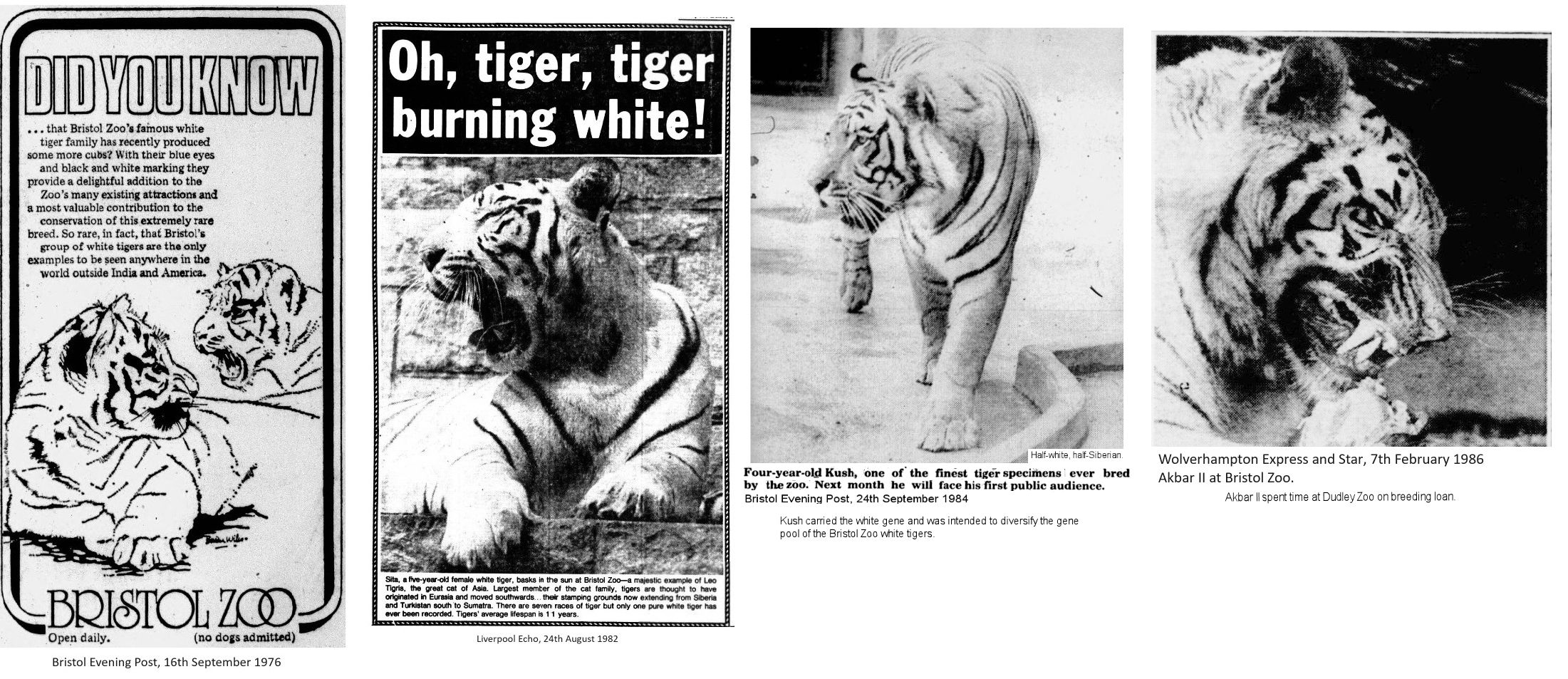
Bristol Zoo's last white male, Akbar II, was loaned to Dudley Zoo and paired with an orange tigress called Starlight. Two male white tigers were transferred to Dudley Zoo from Bristol Zoo and an unrelated orange male was introduced to Bristol Zoo. According to Wolverhampton Express and Star (14th April 1978) Dudley Zoo was to get three two-and-a-half year old white tigers from Bristol Zoo. They had originally planned to have two white tiger cubs, but decided to get three adults as a major attraction. Wolverhampton Express and Star (7th July 1978) reported that Dudley Zoo was the sixth zoo in the world to have white tigers when males Akbar II and Shiva arrived from Bristol Zoo, which was the only other European zoo to have white tigers. The two tigers were born in 1976. This report clarifies the identity of the tigers sent to Dudley: Bristol Zoo's Shiva and Jehan do not appear in the International Tiger Studbook as going to Dudley Zoo from Bristol.
In 1978, Dudley Zoo moved Starlight, daughter of Moonlight, (both orange tigresses) in with their white tigers for breeding. (Wolverhampton Express and Star, 10th August 1978). In 1978, Starlight and Akbar II were introduced to each other and after a "short boxing match" they settled down to eat together; keepers hoped they would soon start mating. Any cubs would be tawny, carrying the white gene. (Sandwell Evening Mail, 7th October 1978). According to the Birmingham Daily Post (11th June 1979), Akbar II was separated from his intended mate, a Bengal tigress named Moonlight, at Dudley Zoo in order to trigger their mating instincts. Both were 3 years old. Akbar II returned to Bristol Zoo in 1982 and when he died in 1986 (stomach abscess) he was their last white tiger.
In 1983, white tigress Nanda and orange tiger Sanka, at Dudley Zoo, produced either two or three orange cubs with the hope that the cubs would go on to produce valuable white tigers in the future. When Nanda returned to Bristol Zoo, Dudley Zoo hoped to keep one of the cubs for breeding white tigers in the Black Country.
At one point Bristol Zoo held one third of the entire global captive population of white tigers, but they were removed from the collection in the mid-1980s. The white tigers of Bristol Zoo are documented by "Wildlife Conservation And The Modern Zoo" (1981) by Gordon Woodroffe.
Bristol Evening Post (24th September 1984) reports that the zoo was home to seven tigers "including the magnificent half-white, half-Siberian Kush. At about 10ft from nose to tip to tail, and weighing in at 450-500lbs., four-year-old Kush is in Brian's opinion the finest tiger the zoo has bred. Yet he has never been seen by the general public. Part of Kush's job is to retain the vital white tiger genes which have taken Bristol zoo to the forefront of breeding this species. Hollywood has been his only home, and he pads his cage like a star in need of a feature film to display his good looks."
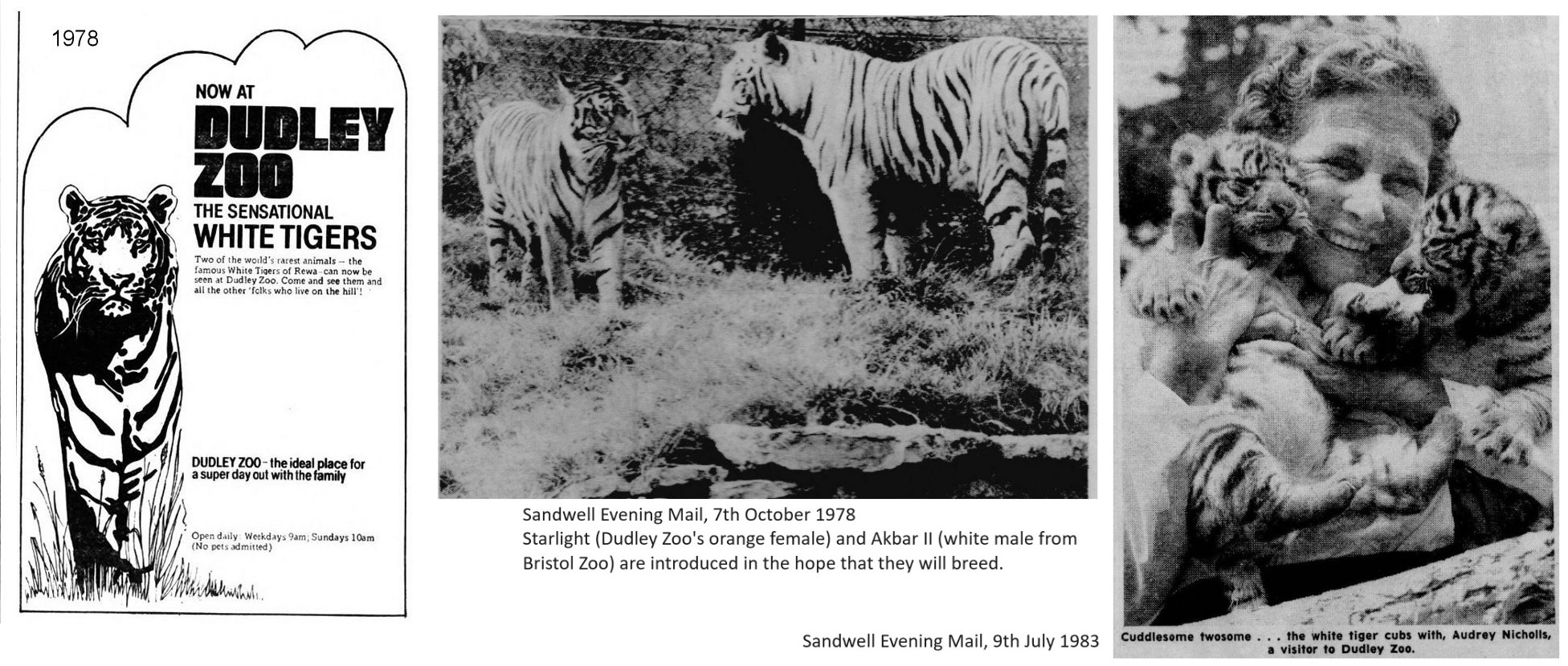
The elderly white tigress that died in Dudley zoo around 1985 was the last living pure Bengal descendant of the original white brother-sister pair sent to Bristol Zoo from India. Bristol's remaining tigers were not pure Bengal tigers. Several litters of orange tigers carrying the white gene were produced between 1989 and 1991 at Bristol Zoo from a white female mated to an orange male, and these were the last descendants of the Bristol white tiger line. The last descendants of Champak and Chameli at Bristol Zoo were a group of orange tigers sold via Ravensden Zoo Co Ltd to senator Zahid, Akhtar of Karachi, Pakistan. The senator had no idea they carried white genes until he gave away some of his tigers to Lahore Zoo where they had white offspring. Had he known, he would have obtained a better price for them. Three orange females carrying the white gene, born in 1989, 1990 and 1991 at Bristol (related but from different litters) went from Bristol Zoo to Longleat Safari Park: Nepti, Schalla and Suki. These were not pure Bengal tigers. Longleat may have sent one to Glasgow and bred the other(s) to their white male from Columbus Zoo.
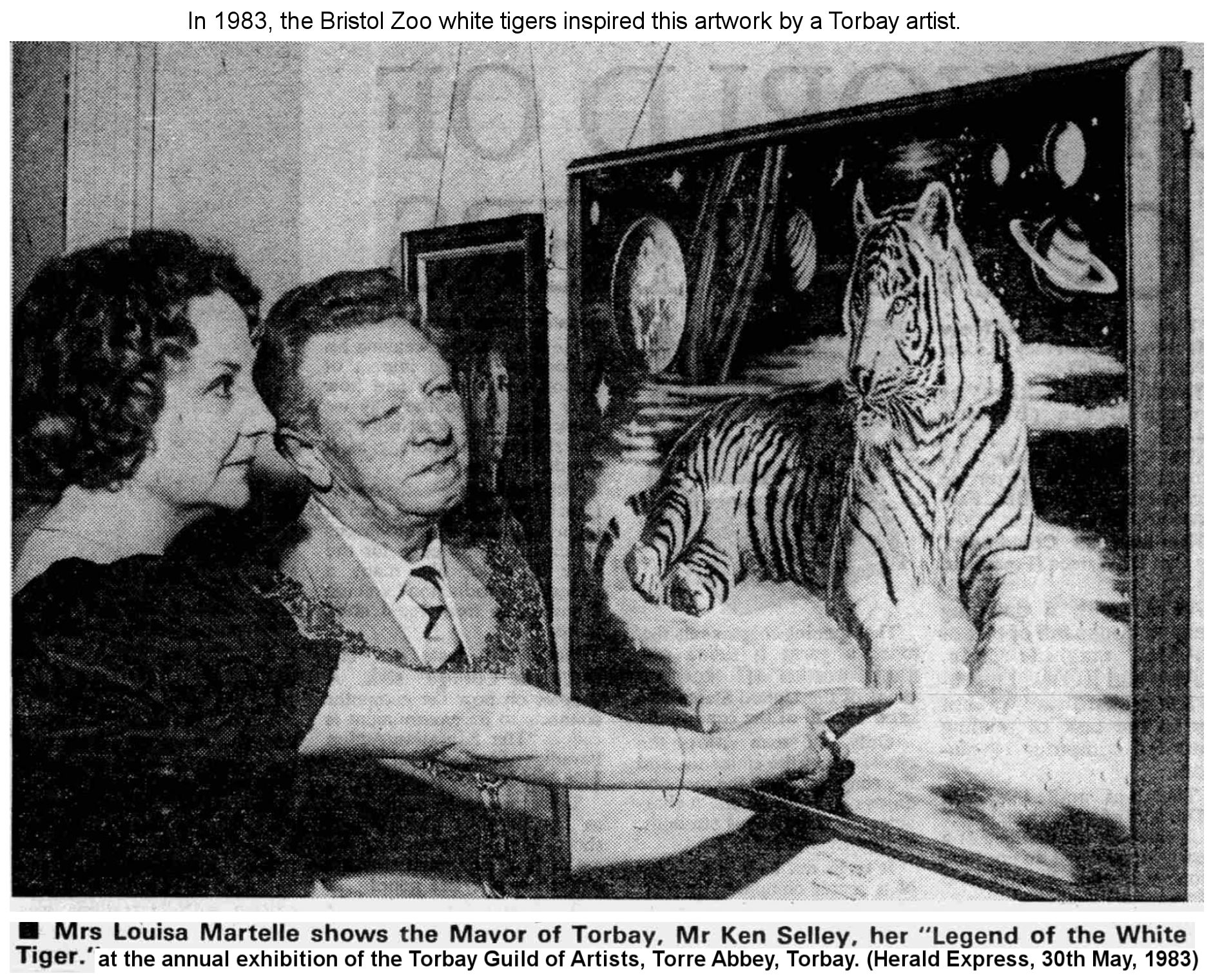
LONGLEAT (CHIPPERFIELD CIRCUS) AND GLASGOW ZOO

In the late 1980s, Longleat Safari Park imported a non-studbook male white tiger of the American strain from Columbus Zoo (Ohio). He was part of a collection that included 6 to 9 orange females at Longleat, which also housed many of Chipperfield Circus's animals. These produced numerous cubs in the following years. Longleat was the home of the Chipperfield circus animals.
Bristol Evening Post (28th March 1989) says "At Longleat in Wiltshire record crowds of 15,000 turned out to see Mayura the white tiger, with queues of up to a mile near the new Warminster by-pass." At this point Mayura was advertised as the only white tiger in Britain. Mayura and other tigers resided in the park's spacious wooded "Tiger Territory" exhibit with several tigresses that carried white-tiger genes.
When the later generations were bred amongst themselves they exhibited even more colour variations including "ginger" (golden). In the 1990s, a litter bred from an orange female carrying white genes mated to a golden male produced a mix of orange, golden and stripeless white cubs. The stripeless white tiger went to Japan. Golden tiger Butu came from that pairing; he was hand-reared and was one of 7 or 8 golden tigers bred by Longleat. Butu went to Glasgow Zoo.
In 1990, Sanjay and Simla, 12 month old male white tigers from Columbus Zoo, Ohio were sent to Longleat to join the white Bengal tiger breeding programme there. They were later introduced to white tigress Chandi at Longleat for breeding. Chandi made her first appearance in the Chipperfield Circus in May 1990 and in 1991 was reported to be the only performing white tiger in a European circus.
Chart 3.1a3b: Chandi Genealogy (large image, opens in new window)
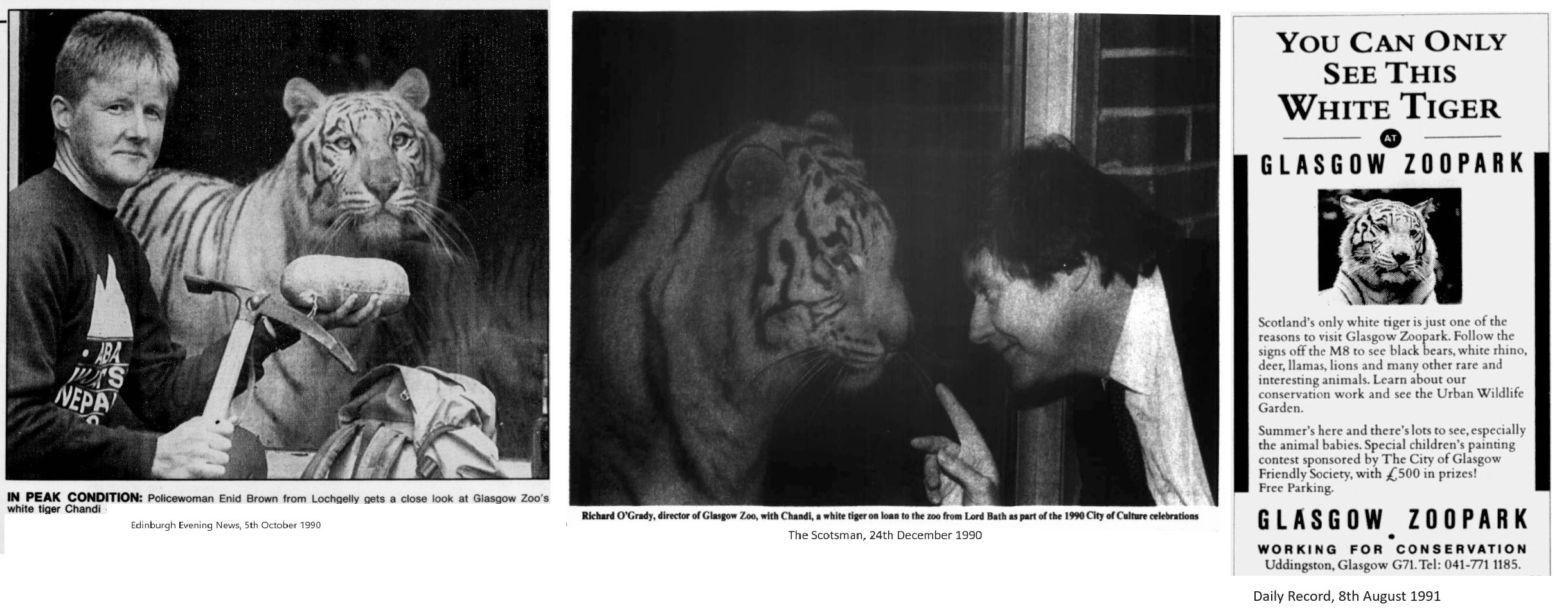
In 1990, as a contribution to the festivities during Glasgow's year as European City of Culture, a white tiger was loaned to Glasgow Zoo by Lord Bath and the Chipperfield family (i.e. Longleat Safari Park). Chandi, a white female with blue eyes and chocolate stripes arrived at Glasgow Zoo on 27th June, 1990 and was a great attraction up until September 1990. According to the Aberdeen Press and Journal (28th June, 1990) Chandi was the first white tiger to be seen in Scotland. Chandi shared an enclosure with male orange tiger, so she was presumably also on breeding loan. There were around 100 white tigers in captivity at the time. In 1991, Chandi produced a litter of four – two orange, two white – at Longleat, but rejected them. The two white cubs were named Bianca and Alba. One of the orange cubs died and Alba died at 4 weeks old. Roger and Mary Chipperfield said it was quite normal for tigresses to reject their first litter, and they hand-reared the three surviving cubs. (Western Daily Press, 8th October 1991)
By the late 1990s, Glasgow Zoo had Ayesha, an Aspinall-bred orange Bengal tigress from Howlett's Zoo in Kent. Two female cubs born in November 1998 remained with her while Butu, the six year old ex-Longleat golden male of the Columbus Zoo (Ohio) strain, went on breeding loan to a Spanish zoo in Spring 2000 to diversify the gene pool there. Butu and Ayesha had bred regularly and all their cubs were orange carrying both white and stripeless genes from Butu. In 2000 Butu had moved to Germany to be with two females, one white, the other golden. He was to return to Glasgow in autumn 2000, unless Glasgow Zoo could obtain an unrelated male from elsewhere. Glasgow Zoo, Scotland had previously had white tigers on loan from Lord Bath and the Chipperfield Circus (i.e. Longleat) before it closed and referred to them as "American non-studbook white tigers" i.e. mongrels.
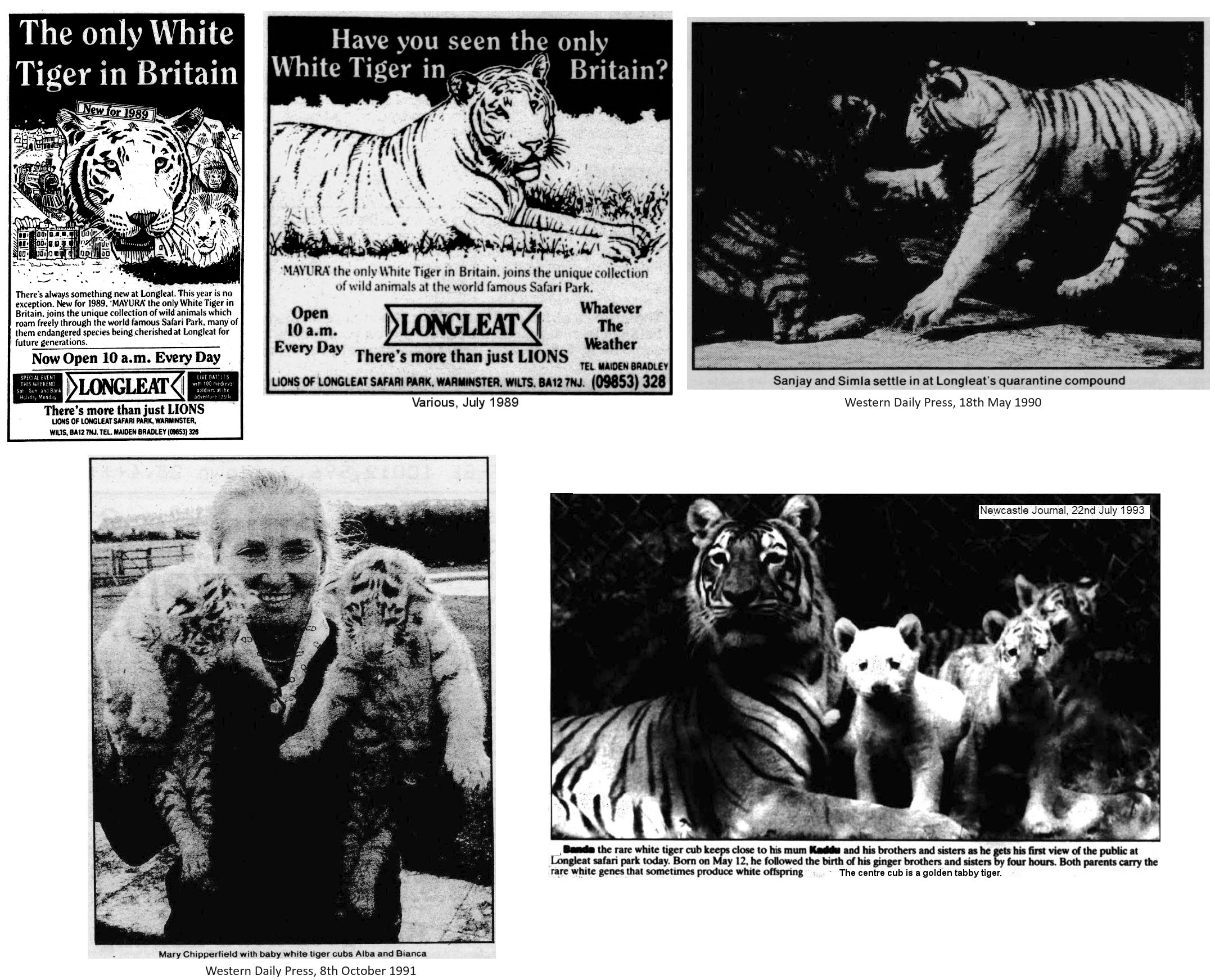
SOUTHAM ZOO
Three tiger cubs were born at Southam Zoo, Warwickshire, on 16th-17th April, two of which were white and thought to be the only white tiger cubs in Europe at the time. (Banbury Guardian, 21st April 1983). In a "Ten Years Ago" article, he Northampton Chronicle and Echo (5th May 1993) reported that one of the two valuable "snow tigers" born in April 1983 to the zoo's famous tigress, Emma, had died in May 1983. The remaining white tiger cub, Snowball, was the only white tiger cub in Europe and was estimated to be worth £30,000. It reported that the cub is rare because "it is impossible to breed white tigers. They are freaks of nature."
WEST MIDLANDS SAFARI AND LEISURE PARK
Lichfield Mercury, 27th May 1999, carried this report about white tigers: "If you fancy a unique encounter with a beautiful and rare animal, why not visit the West Midlands Safari and Leisure Park near Bewdley, where two white Bengal tigers go on show to visitors for the very first time at the park from Thursday, May 27. The pair, called Tahas and Tikua, are just 18 months old and were imported from Junsele Zoo, in Sweden, in December. They have been integrated into a small group of young Bengal tigers, born at West Midlands Safari Park, and it is anticipated that a further four will join them at a later date. White tigers are neither albinos, nor a separate species. They are rare white Bengal Tigers, of which barely 150 exist in the world, with no more than 12 being found in this country. The two white tigers at West Midlands Safari Park are in rabies quarantine after a landmark decision by MAFF to allow the first ever drive-through quarantine in this country."
ISLE OF WIGHT ZOO
Isle of Wight Zoo's white tiger Zena and her older sister Zia were offspring of Sonar x Chandi. The zoo also had Diamond (a golden tiger) and his tawny sister Aysha, who were born at Dublin Zoo.
Textual content is licensed under the GFDL.
FOOTNOTE
Most white tiger websites have a pro- or anti-agenda and variously claim to give facts, truths or debunk myths but give misinformation or have hidden agendas. I stick to facts and deductions based on facts. Some information is documented, some is from personal correspondence with zoos, and some is from the recollections or personal notes of people involved with circus or zoo tigers where records were have been lost or destroyed. Even the different editions of tiger studbooks are inconsistent. Information from my pages, which are frequently updated, is widely copied on those other sites. Some sites have tried to claim I copied their work.
|
BACK TO HYBRID & MUTANT BIG CATS INDEX |